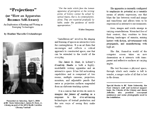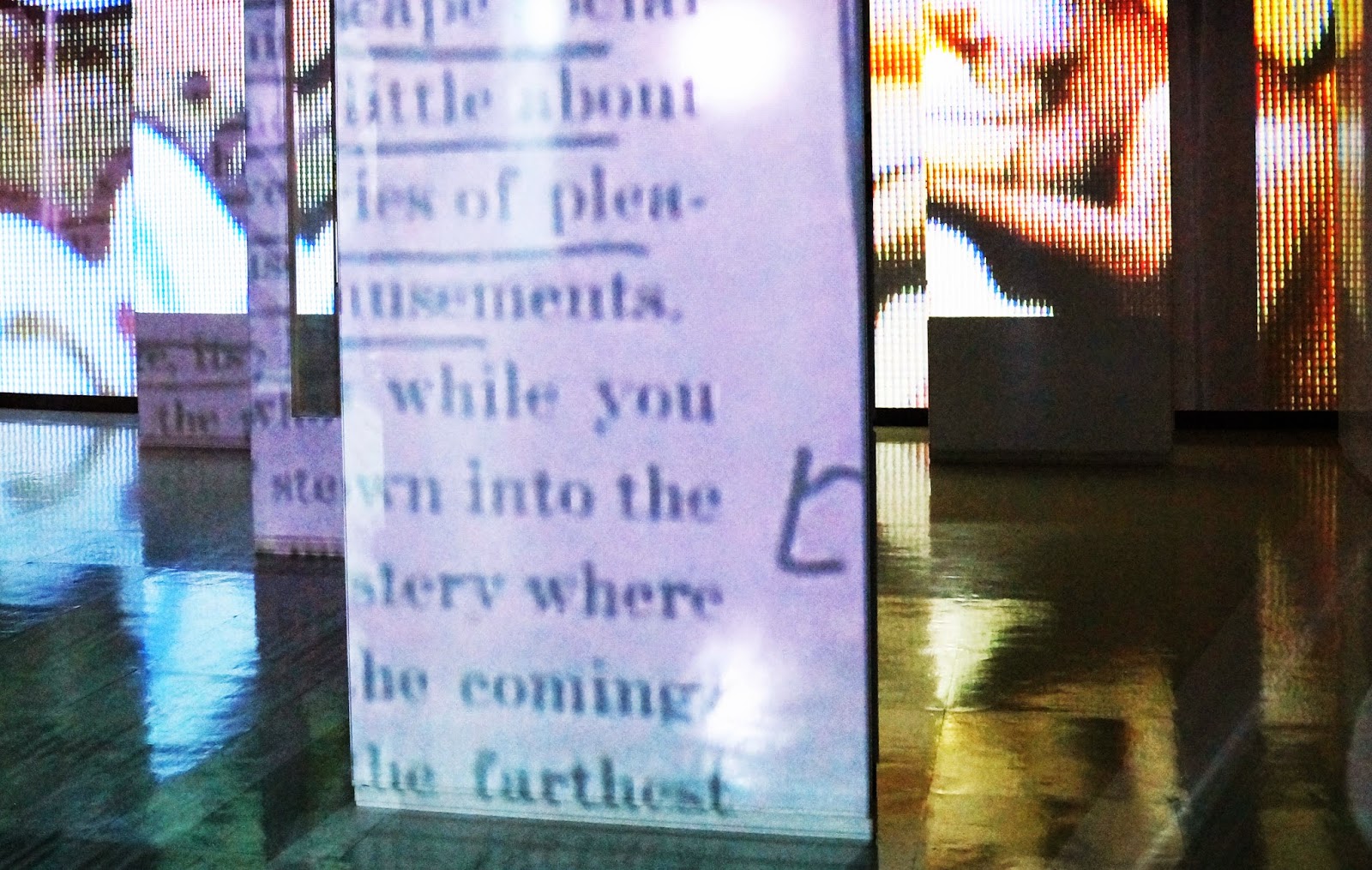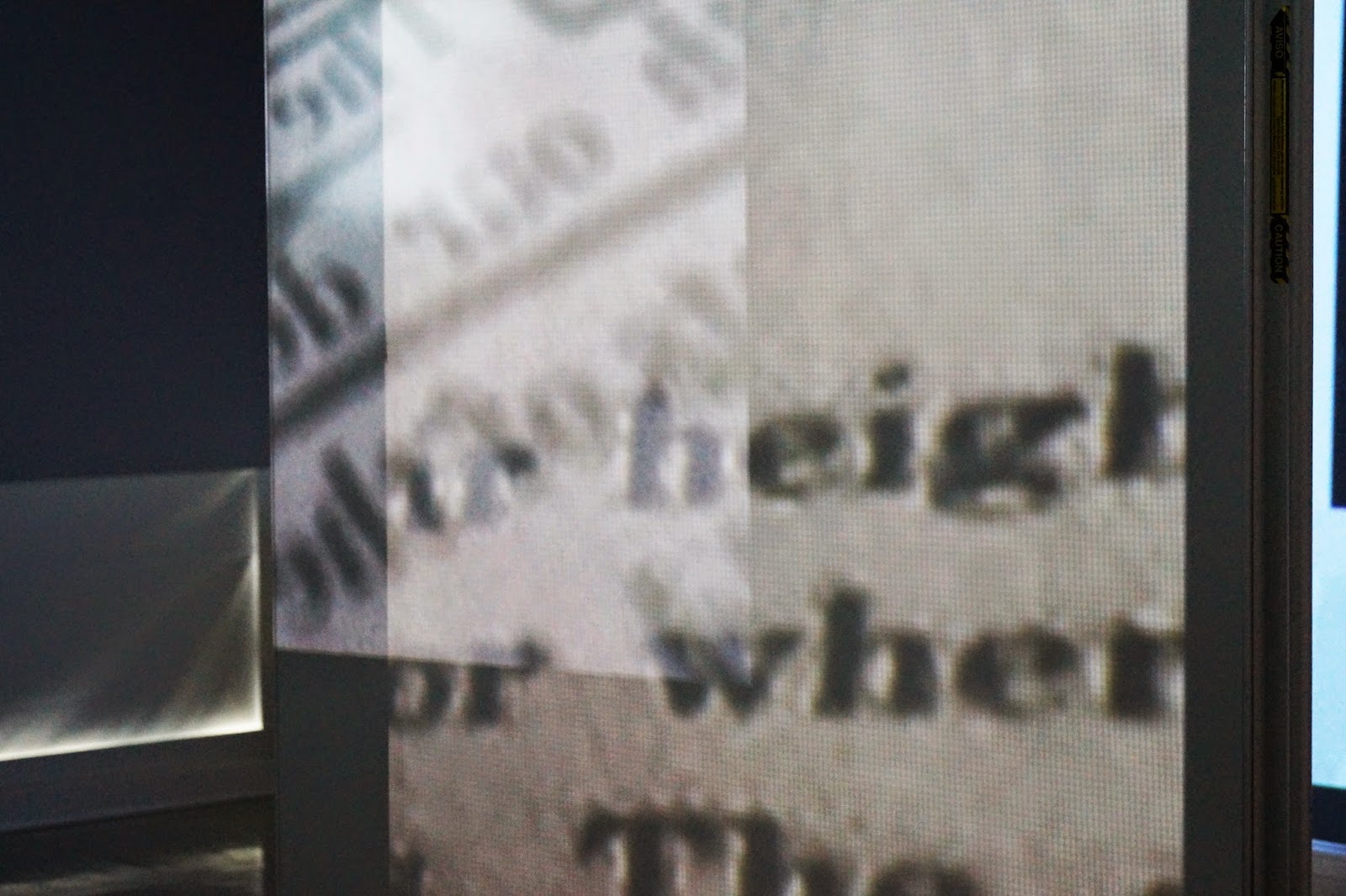Slideshows & Projected Content
Below, links to the slideshows used in Projections: Reading and Writing in Emerging Technologies (or How an Apparatus Becomes Self-Aware) are provided. Further details about the location of each slideshow are detailed in the "Apparatus" section of this project.
Click image above to view the Slideshow that was projected onto the North and South Walls.
Click image above to view the Slideshow that was projected onto the North-Midi and South-Midi Walls.
Click image above to view Slideshow used as Artist Statement.
Click image above to view Slideshow used for presentation of Theoretical Background.
Click image above to view Slideshow used for Process presentation.
Click image above to view Slideshow Inviting Visitor Participation
Various Photographs from the April 5, 2014 Exhibition
ABOVE: William Blake obsession meets search for Cold War propaganda.
ABOVE: Klee's 'Angelus Novus' breaks up a close up shot of some flowers I stumbled on many years ago. Benjamin wrote of this painting in his Nineth Thesis on the Philosophy of History: "A Klee drawing named 'Angelus Novus' shows an angel looking as though he is about to move away from something he is fixedly contemplating. His eyes are staring, his mouth is open, his wings are spread. This is how one pictures the angel of history. His face is turned toward the past. Where we perceive a chain of events, he sees one single catastrophe that keeps piling ruin upon ruin and hurls it in front of his feet. The angel would like to stay, awaken the dead, and make whole what has been smashed. But a storm is blowing from Paradise; it has got caught in his wings with such violence that the angel can no longer close them. The storm irresistibly propels him into the future to which his back is turned, while the pile of debris before him grows skyward. This storm is what we call progress."
ABOVE: Many philosophical and literary themes underlying this story emerged in this image. In the foreground, grocery store orchids wrapped in plastic reflect onto the shiny surfaces of the panels. Henry Miller's Tropic of Cancer was integral to the work of Deleuze who I studied in depth while developing my approach to Benjamin's arcades. The novel itself provides an excellent example of a flâneuristic narrative technique, one that blends the mind of the narrator with his surroundings.
ABOVE: Walter Benjamin. (Photo found on http://thefrailestthing.files.wordpress.com/2011/09/walter-benjamin.jpg)
ABOVE: Henri Fantin-Latour's "Portrait of Edouard Manet," completed in 1867. Manet's work is often associated with the flaneur.
ABOVE: Photo found at
ABOVE: Cover of the 1999 English edition of The Arcades Project.
ABOVE: "The Tyger" by WIlliam Blake. (Image found at http://www.nimbi.com/copyright/william_blake_the_tyger.jpg)
ABOVE: The above images and specifications were taken from NCSU's information website for the Creativity Studio available at https://magnolia.lib.ncsu.edu/tech_specs/?room=crn
ABOVE: NCSU's Standard Configuration is pictured. Panels are typically stored providing the most amount of open space. The studio has various furnishings, among them several chairs and tables.
ABOVE: Configuration from 1-4PM on April 5, 2014
ABOVE: Cnn.com projected onto an early configuration. (Above photo, courtesy of Jason Jefferies.)
ABOVE: photo, Cnn.com projected onto floor. (Photo courtesy of Jason Jefferies.)
ABOVE: Raw shots of the monitor: these would be cropped and color edited in Photoshop before being format to fit the various components of the Creativity Studio.
ABOVE: Graffiti and some strange Steampunk-style skull sculpture in the background. (Photo courtesy of Jason Jefferies.)
ABOVE: A picture of some graffiti I found while wandering the internet. Graffiti projected more beautifully than any other type of image onto the apparatus. The texture of the computer monitor blends interestingly with the texture of the cement wall.
ABOVE: Images are from my personal collection. I chose them for their landscape qualities. They contrasted the split-up world of framed search results with a broad-stroked wholeness that fractured inside the apparatus at various vantage points.
ABOVE: Photos, courtesy of Jason Jefferies.
VIDEO: Walkthrough from South Entrance
This video shows a walkthrough of the installation on April 5, 2014 starting in the South Entrance and ending at North Entrance. CLICK image to play video.
VIDEO: Circular Walkthrough Starting and Ending at North Entrance
This video was filmed using a cart, entering and exiting through the North Entrance. CLICK image to play video.
VIDEO: Walkthrough from North Entrance to South Entrance
This video features a walkthrough of the installation, beginning at the North Entrance and exiting at the South Entrance. CLICK image to play video.














































































